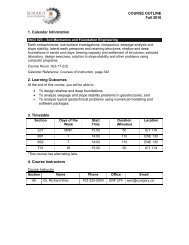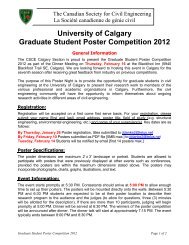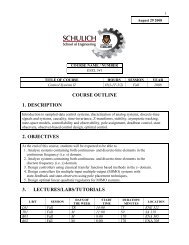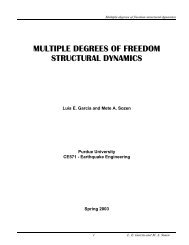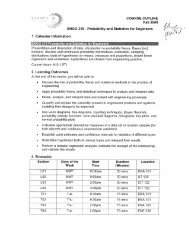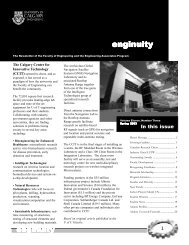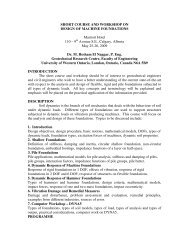Part 2 - Seismic Design Provisions In NBCC 2005 - The Schulich ...
Part 2 - Seismic Design Provisions In NBCC 2005 - The Schulich ...
Part 2 - Seismic Design Provisions In NBCC 2005 - The Schulich ...
You also want an ePaper? Increase the reach of your titles
YUMPU automatically turns print PDFs into web optimized ePapers that Google loves.
1<br />
<strong>Seismic</strong> <strong>Design</strong> <strong>Provisions</strong><br />
<strong>In</strong><br />
<strong>NBCC</strong> <strong>2005</strong><br />
by<br />
C. James Montgomery<br />
CSCE Workshop<br />
Calgary 23 January 2007
2<br />
Road Map<br />
• Earthquakes<br />
• <strong>Seismic</strong> Risk in Canada<br />
• Behaviour of Structures <strong>In</strong> Earthquakes<br />
• Structural Dynamics<br />
• <strong>Design</strong> Philosophy<br />
• <strong>NBCC</strong> <strong>2005</strong>
Earthquakes<br />
3
4<br />
Global <strong>Seismic</strong>ity and Tectonic Plates<br />
Bolt, 1993<br />
NRC website
Movement At Faults<br />
5
6<br />
Strain<br />
energy is<br />
released<br />
when slip<br />
occurs at<br />
fault
Earthquake<br />
Magnitude<br />
is a measure of<br />
the amount of<br />
energy released<br />
at the source<br />
7
8<br />
Richter Magnitude<br />
• Richter defined magnitude of a local<br />
earthquake as the logarithm to base ten<br />
of the maximum seismic-wave<br />
amplitude (in thousands of a millimeter)<br />
recorded on a standard seismograph at<br />
a distance of 100 kilometers from the<br />
earthquake epicenter.
9<br />
Ground<br />
motions occur<br />
as earthquake<br />
waves<br />
propagate
10<br />
Modified Mercalli<br />
<strong>In</strong>tensity for New<br />
Madrid, Missouri<br />
earthquake<br />
16 Dec 1811<br />
(MM <strong>In</strong>tensity is a<br />
measure of the<br />
intensity of ground<br />
shaking at a<br />
particular location)<br />
Bolt, 1993
11<br />
Modified Mercalli <strong>In</strong>tensity Scale<br />
<strong>In</strong>tensity Description Peak<br />
Velocity<br />
(mm/s)<br />
Peak<br />
Acceleration<br />
(g)<br />
VI<br />
Felt by all, many frightened. Some heavy<br />
furniture moved. Damage slight.<br />
50-80 0.06-0.07<br />
VIII<br />
X<br />
XII<br />
Damage slight in specially designed<br />
structures; considerable in ordinary<br />
structures with partial collapse. Panel<br />
walls thrown out of frame structures.<br />
Heavy furniture overturned.<br />
Some well-built wooden structures<br />
destroyed; most masonry and frame<br />
structures destroyed. Landslides<br />
considerable.<br />
Damage total. Waves seen on ground<br />
surface. Objects thrown into the air<br />
200-300 0.25-0.30<br />
>600 >0.60
Strong Ground Motions At A Site<br />
12
13<br />
<strong>Seismic</strong> Risk in Canada<br />
http://earthquakescanada.nrcan.gc.ca
15<br />
<strong>Seismic</strong> Risk<br />
Adams, et al. Trial <strong>Seismic</strong> Hazard Maps of Canada –<br />
1999…, Geological Survey of Canada, Open File<br />
3724
20<br />
<strong>Seismic</strong> Risk<br />
Location PGA * S a (0.2) * S a (0.5) * S a (1.0) * S a (2.0) *<br />
Calgary 0.088 0.15 0.084 0.041 0.023<br />
Edmonton 0.059 0.12 0.056 0.023 0.008<br />
Toronto 0.17 0.26 0.13 0.055 0.015<br />
Vancouver 0.46 0.94 0.64 0.34 0.17<br />
*<br />
Expressed as a ratio to g
21<br />
<strong>Design</strong><br />
Response<br />
Spectra
22<br />
Behaviour of Structures in<br />
Earthquakes
23<br />
Northridge, CA *<br />
Date 17 Jan 1994<br />
Magnitude 6.7<br />
Fatalities 60<br />
<strong>In</strong>jured 7,000+<br />
Homeless 20,000+<br />
Buildings damaged 40,000+<br />
Cost<br />
$13-20 Billion<br />
*<br />
From EERI website
Northridge Meadows Parking Lot<br />
24
Parking Garages<br />
25
26<br />
Parking<br />
Structures
27<br />
I-5 at Gavin<br />
Canyon
28<br />
Suspended Walkways, Cal State<br />
Structural Separation Not Adequate
Bullocks Store<br />
29
Apartment Building on Wilshire<br />
30
St. John’s Hospital Admin Bldg<br />
31
Ruptured Utility Pipe<br />
32
HSS fracture due to local buckling<br />
33
<strong>Seismic</strong> Isolator at USC Hospital<br />
34
35<br />
Failure of Concrete Members<br />
Mitchell et al. 1995
36<br />
Kobe, Japan *<br />
Date 16 Jan 1995<br />
Magnitude 6.9<br />
Fatalities 5,502<br />
<strong>In</strong>jured 36,896<br />
Homeless<br />
Buildings damaged 200,000<br />
Cost<br />
*<br />
From EERI website
37<br />
Splice Failure<br />
at Weakest<br />
Point of<br />
Tapered<br />
Column<br />
(Elevated<br />
Railway near<br />
Sanomiya)
Hanshin Expressway – Pier 142<br />
38
39<br />
Hanshin<br />
Expressway<br />
Shear Failure –<br />
Pier 165<br />
Splice Failure –<br />
Pier 99
40<br />
Damage<br />
to<br />
Railway<br />
Lines
41<br />
Failure at<br />
<strong>In</strong>termediate<br />
Floors
42<br />
Pancake<br />
Collapse
43<br />
Soft-Storey<br />
Failure<br />
Sanomiya
Seven Storey Reinforced Concrete Frame<br />
Failed At Fifth Floor Due To Setback<br />
44
45<br />
Michoacan (Mexico City) *<br />
Date 19 Sep 1985<br />
Magnitude 8<br />
Fatalities 9,500<br />
<strong>In</strong>jured 30,000<br />
Homeless 100,000<br />
Buildings damaged<br />
Cost<br />
412 collapsed<br />
3,124 seriously<br />
damaged in Mexico City<br />
$3-4 Billion<br />
∗<br />
From EERI website
46<br />
Zona<br />
Rosa
Zona Rosa<br />
47
Zona Rosa<br />
48
Continental Hotel on Reforma<br />
49
50<br />
Collapsed<br />
Buildings
51<br />
Damaged<br />
Buildings
52<br />
Damaged<br />
Building and<br />
Parkade
53<br />
Illustrates<br />
Need For<br />
Separation<br />
Between<br />
Adjacent<br />
Buildings
54<br />
<strong>Part</strong>ially<br />
Collapsed<br />
Buildings
55<br />
Relationship Between Strength<br />
and Ductility<br />
• <strong>In</strong> seismic design, building can be proportioned to respond<br />
elastically, with restricted ductility or with full ductility<br />
• <strong>In</strong> general members must be able to resist several load cycles<br />
Paulay and Priestly 1992
56<br />
Hysteresis Loops For Some<br />
Concrete Systems<br />
Paultre, et al. 1989
57<br />
Hysteresis Loops For Some<br />
Structural Members<br />
Krawinkler and Popov, 1982; Paulay and Priestly, 1992
58<br />
Structural Dynamics<br />
Chopra, 1981<br />
Clough and Penzien, 2003
59<br />
One-Storey Building Idealized as<br />
Single-Degree-of-Freedom System<br />
Subjected to dynamic<br />
forces<br />
Subjected to ground<br />
motion
60<br />
mx && +<br />
cx&<br />
+<br />
kx<br />
=<br />
0<br />
f<br />
=<br />
1<br />
T<br />
=<br />
ω<br />
=<br />
2π<br />
1<br />
2π<br />
k<br />
m<br />
Free Vibration<br />
ξ =<br />
2<br />
c<br />
km
61<br />
Ground<br />
Motion<br />
Response of<br />
SDF systems<br />
Plot of Elastic Spectral<br />
Displacements, S d<br />
(Displacement Response<br />
Spectrum)
62<br />
Elastic Response of Single-<br />
Degree-of-Freedom Systems<br />
Elastic Acceleration Response Spectrum (S a = ω 2 S d )
63<br />
Multi-Degree-of-Freedom Systems<br />
• MDF building will respond to<br />
earthquake in several normal<br />
modes of vibration<br />
• <strong>In</strong> a normal mode, MDF<br />
vibrates harmonically while<br />
maintaining a characteristic<br />
deflected shape<br />
• Total response can be<br />
estimated by combining<br />
responses in various normal<br />
modes<br />
• <strong>In</strong> general, response in first<br />
mode is most important<br />
t
64<br />
Multi-Degree-of-Freedom Systems<br />
• Equations of motion<br />
[ m ]{ x& ( t)<br />
} + [ c]<br />
{ x&<br />
( t)<br />
} + [ k] x(<br />
t)<br />
} = −[ m] { 1}<br />
{ & x<br />
g<br />
• For simple harmonic free vibration, can<br />
solve for frequencies of vibration and<br />
mode shapes<br />
[ ]<br />
2<br />
k −ω<br />
[ m] { φ}<br />
= ( 0)<br />
frequencies ω , ω ,...<br />
1<br />
2<br />
and mode<br />
shapes<br />
{<br />
() 1<br />
}<br />
( 2<br />
φ , φ )<br />
}<br />
{ ,...
65<br />
Multi-Degree-of-Freedom Systems<br />
• Total response of a structure can be<br />
developed by superimposing the<br />
response in each mode<br />
{ x = ∑ φ Y<br />
n = 1 n<br />
{ }<br />
N ( n )<br />
}<br />
• Use modal orthogonality to uncouple<br />
equations
66<br />
Multi-Degree-of-Freedom Systems<br />
{<br />
( n)<br />
}<br />
T<br />
[ ]{<br />
( m)<br />
φ m φ }<br />
{<br />
( n)<br />
}<br />
T<br />
[]{<br />
( m)<br />
φ c φ }<br />
{<br />
( n)<br />
}<br />
T<br />
[ ]{<br />
( m)<br />
φ k φ }<br />
and<br />
L<br />
n<br />
=<br />
M<br />
= 〈<br />
0<br />
( m)<br />
T ( n)<br />
{ φ } [ m] { φ }<br />
C<br />
= 〈<br />
0<br />
( m)<br />
T ( n)<br />
{ φ } [] c { φ }<br />
n<br />
( m)<br />
T ( n)<br />
{ φ } [ k] { φ }<br />
Also L<br />
K<br />
= 〈<br />
0<br />
{<br />
( n)<br />
}<br />
T<br />
φ [ m] {1 }<br />
n<br />
n<br />
for<br />
=<br />
n<br />
for<br />
M<br />
= 〈<br />
0<br />
Cn<br />
for n = m<br />
= 〈<br />
0 for n ≠ m<br />
K<br />
for n = m<br />
= 〈<br />
n0<br />
for ≠n<br />
≠ m<br />
( n)<br />
T<br />
{ φ } [ m] {1 }<br />
for<br />
for<br />
for<br />
n<br />
for n = m<br />
for n ≠ m<br />
n<br />
n<br />
n<br />
for n<br />
≠<br />
=<br />
≠<br />
m<br />
m<br />
=<br />
=<br />
m<br />
m<br />
m<br />
m
67<br />
Multi-Degree-of-Freedom Systems<br />
• <strong>The</strong> result is a set of N uncoupled modal<br />
equations<br />
M<br />
n<br />
Y&<br />
n<br />
+<br />
C<br />
n<br />
Y&<br />
n<br />
+<br />
K<br />
n<br />
Y<br />
• Displacement response in n-th mode (by<br />
analogy to response for SDF system)<br />
Y<br />
n<br />
( t)<br />
=<br />
where<br />
L<br />
M<br />
x<br />
n<br />
n<br />
n<br />
with n − th<br />
x<br />
n<br />
( t)<br />
=<br />
( t)<br />
response<br />
frequency<br />
n<br />
of<br />
of<br />
=<br />
−L<br />
n<br />
SDF<br />
& x<br />
vibration<br />
g<br />
System
68<br />
Multi-Degree-of-Freedom Systems<br />
• Displacement vector from all modal<br />
responses obtained by superposition<br />
N<br />
{ } ∑<br />
N<br />
{<br />
( n )<br />
} ∑{<br />
( n )<br />
}<br />
Ln<br />
x( t)<br />
= φ Y<br />
=<br />
n<br />
= φ xn(<br />
t)<br />
n 1<br />
n=<br />
1 M<br />
n<br />
• Recall that spectral displacement in the<br />
n-th mode is equal to the maximum<br />
displacement response of SDF system<br />
S =<br />
( n)<br />
d<br />
x<br />
n,max
69<br />
Multi-Degree-of-Freedom Systems<br />
• Upper bound displacement vector (sum of<br />
absolute values of maximum modal<br />
displacements)<br />
N<br />
N<br />
{ } ∑ {<br />
( n)<br />
} ∑ {<br />
( n )<br />
}<br />
Ln<br />
( n)<br />
x<br />
upper bound<br />
≤ xmax<br />
= φ Sd<br />
n=<br />
1<br />
n=<br />
1 M<br />
n<br />
• Probable displacement vector (square root of<br />
the sum of squares of maximum modal<br />
displacements)<br />
N<br />
{ } {<br />
( n)<br />
x ≈ x }<br />
prob<br />
∑<br />
n=<br />
1<br />
( )<br />
2<br />
∑ {<br />
( n<br />
= ⎜ )<br />
}<br />
max<br />
φ<br />
N<br />
n=<br />
1<br />
⎛<br />
⎜<br />
⎝<br />
L<br />
M<br />
n<br />
n<br />
S<br />
( n)<br />
d<br />
⎞<br />
⎟<br />
⎠<br />
2
Multi-Degree-of-Freedom System<br />
• Elastic force vector in n-th mode<br />
{ } [ ]{ }<br />
f<br />
( n)<br />
( t)<br />
= k φ<br />
( n)<br />
Y ( t)<br />
s<br />
n<br />
• But<br />
−ω<br />
2<br />
n<br />
• <strong>The</strong>refore<br />
[ ]{<br />
( n)<br />
} [ ]{<br />
( n)<br />
m + } φ k φ = 0<br />
{<br />
( n)<br />
( )} 2[ ]{<br />
( n)<br />
f t = ω m φ }<br />
s<br />
=<br />
n<br />
L<br />
Y<br />
[ ]{<br />
( n)<br />
}<br />
n 2<br />
m φ ω x ( t)<br />
n<br />
M n<br />
n<br />
n<br />
70
71<br />
Multi-Degree-of-Freedom Systems<br />
• Recall<br />
S<br />
( n)<br />
a<br />
• Maximum elastic force N vector in n-th mode<br />
{<br />
( n)<br />
} [ ]{<br />
( n)<br />
}<br />
n ( n)<br />
f = m φ S<br />
s,max<br />
= ω S = ω<br />
2<br />
n<br />
n<br />
d<br />
L<br />
M<br />
n,max<br />
• Base shear in n-th mode<br />
V<br />
( n)<br />
e<br />
( t)<br />
=<br />
N<br />
∑<br />
i=<br />
1<br />
f<br />
( n)<br />
si<br />
2<br />
n<br />
V<br />
( n)<br />
e<br />
( t)<br />
x<br />
( t)<br />
=<br />
∑<br />
i=<br />
1<br />
n<br />
f<br />
( n)<br />
si<br />
( t)<br />
a
Multi-Degree-of-Freedom Systems<br />
• Maximum base shear in n-th mode<br />
N<br />
∑<br />
( n)<br />
V e<br />
= f<br />
,max<br />
i=<br />
1<br />
( n)<br />
si,max<br />
• Overturning moment in n-th mode<br />
M<br />
( n)<br />
e<br />
where<br />
( t)<br />
h<br />
= ∑ h<br />
i<br />
N<br />
i=1<br />
i<br />
f<br />
( n)<br />
si<br />
( t)<br />
= height of i − th floor<br />
• Maximum overturning moment in n-th mode<br />
M<br />
N<br />
( n )<br />
∑<br />
( n)<br />
e,max<br />
= hi<br />
f<br />
si,max<br />
i=<br />
1<br />
72
73<br />
Multi-Degree-of-Freedom Systems<br />
• Can determine the upper bound to the<br />
base shear or overturning moment by<br />
taking the sum of the absolute values of<br />
the modal values.<br />
• Can determine a probable value of the<br />
base shear or overturning moment<br />
taking the square root of the sum of the<br />
squares of the modal values.
74<br />
<strong>In</strong>elastic Response<br />
• Studies by Newmark and others at the<br />
University of Illinois, Wilson and others at<br />
Berkeley, and researchers at many other<br />
institutions have shown that:<br />
– Displacements of a building during an earthquake<br />
are about the same whether the building responds<br />
elastically or inelastically<br />
– Forces, shears and moments in a building are<br />
approximately equal to the forces, shears and<br />
moments obtained assuming the building responds<br />
elastically, divided by the ductility factor (or R-<br />
factor)
<strong>Design</strong> Philosophy<br />
75
76<br />
• Accept damage without collapse<br />
• Minimize loss of life<br />
• Cannot afford to design for no damage
<strong>The</strong>re is always a good reason for “No<br />
Parking” signs<br />
Bolt 1993<br />
77
78<br />
<strong>NBCC</strong> <strong>2005</strong> *<br />
4.1.8 Earthquake Loads and<br />
Effects<br />
*<br />
Alberta Building Code (June 2007)
79<br />
<strong>NBCC</strong> <strong>2005</strong><br />
• 4.1.8.1 Analysis<br />
• 4.1.8.3 General Requirements<br />
• 4.1.8.4 Site Properties<br />
• 4.1.8.5 Importance Factor<br />
• 4.1.8.6 Structural Configuration<br />
• 4.1.8.8 Direction of Loading<br />
• 4.1.8.9 <strong>Seismic</strong> Force Resisting Systems (SFRS), Force<br />
Reduction Factors, System Overstrength Factors<br />
• 4.1.8.10 Additional System Restrictions<br />
• 4.1.8.11 Equivalent Static Force Procedure<br />
• 4.1.8.12 Dynamic Analysis Procedure<br />
• 4.1.8.13 Deflections and Drift Limits<br />
• 4.1.8.14 Structural Separation<br />
• 4.1.8.15 <strong>Design</strong> <strong>Provisions</strong><br />
• 4.1.8.16 Foundation <strong>Provisions</strong><br />
• 4.1.8.17 Elements of Structures, Non-structural Components<br />
and Equipment
80<br />
4.1.8.1 Analysis<br />
• Do not need to consider earthquake<br />
loads and deflections when the design<br />
spectral response acceleration,<br />
expressed as a ratio to gravitational<br />
acceleration, for a period of 0.2 s,<br />
S(0.2), is less than or equal to 0.12.
81<br />
4.1.8.3 General Requirements<br />
• Clearly defined load paths<br />
• Clearly defined <strong>Seismic</strong> Force Resisting<br />
System (SFRS)<br />
• Other building components must go<br />
along for the ride
82<br />
4.1.8.4 Site Properties<br />
• Peak ground acceleration, PGA<br />
• 5% damped spectral response<br />
acceleration values, S a (T)<br />
– Reference conditions – Very dense soil and<br />
soft rock<br />
– 2% probability of exceedance in 50 years<br />
(return period of 2,475 years)
83<br />
4.1.8.4 Site Properties (con’d)<br />
Rosenblueth 1980
84<br />
4.1.8.4 Site Properties (con’d)<br />
• Site classification for soil<br />
– Shear wave velocity, V s<br />
– Standard penetration resistance, N 60<br />
– Undrained shear strength, S u<br />
• Acceleration and velocity based site<br />
coefficients, F a and F v<br />
– Site Class A Hard rock<br />
– Site Class B Rock<br />
– Site Class C Very dense soil and soft rock<br />
– Site Class D Stiff soil<br />
– Site Class E Soft soil
85<br />
4.1.8.4 Site Properties (con’d)<br />
• Coefficients F a and F v vary as a function<br />
of<br />
– Site class<br />
– Spectral response acceleration<br />
• F a varies between 0.7 and 2.1<br />
• F v varies between 0.5 and 2.1<br />
• For Site Class C, very dense soil and<br />
soft rock, F a and F v are 1.0
86<br />
4.1.8.4 Site Properties (con’d)<br />
• <strong>Design</strong> spectral acceleration values of<br />
S(T)<br />
– F a S a (0.2) for T < 0.2 s<br />
– Smaller of F v S a (0.5) or F a S a (0.2) for T = 0.5 s<br />
– F v S a (1.0) for T = 1.0 s<br />
– F v S a (2.0) for T = 2.0 s<br />
– F v S a (2.0)/2 for T > 4.0 s
87<br />
4.1.8.5 Importance Factor, I E<br />
• Post disaster 1.5<br />
• Schools 1.3<br />
• Other 1.0
88<br />
4.1.8.6 Structural Configuration<br />
• Regular structures<br />
• Irregular structures<br />
– Vertical stiffness<br />
– Mass<br />
– Vertical geometry<br />
– <strong>In</strong>-plane discontinuity in<br />
vertical lateral forceresisting<br />
element<br />
– Out-of-plane offsets<br />
– Weak storey<br />
– Torsional sensitivity<br />
– Non-orthogonal systems<br />
• For irregular structures<br />
– Must do a dynamic<br />
analysis<br />
– Restrictions on use
89<br />
Vertical stiffness<br />
irregularily<br />
Weak storey<br />
Caracas 1967<br />
Earthquake<br />
Rosenblueth 1980
90<br />
Torsional sensitivity (1)<br />
Vertical geometric irregularity (2)<br />
Bolt 1993
91<br />
4.1.8.8 Direction of Loading<br />
• SFRS oriented along orthogonal axes<br />
– <strong>In</strong>dependent analysis about each principal<br />
axis<br />
• SFRS not oriented along orthogonal<br />
axes and higher seismic zones<br />
– 100% one direction plus 30% perpendicular<br />
direction
92<br />
4.1.8.9 Force Reduction Factors<br />
and Overstrength Factors<br />
• Force reduction factor, R d<br />
– Factor to reflect system<br />
ductility<br />
– Similar to R-factor in<br />
previous code<br />
– About the same as the<br />
ductility factor measured<br />
in a hysteresis experiment<br />
• Overstrength factor, R o<br />
R<br />
o<br />
=<br />
R<br />
φ<br />
R<br />
yield<br />
R<br />
size<br />
mech<br />
–R f =1/f<br />
–R yield = prob /spec yield<br />
sh<br />
R<br />
R<br />
–R sh strain hardening<br />
–R size discrete mem size<br />
–R mech formation of<br />
collapse mech
93<br />
4.1.8.9 Force Reduction Factors<br />
and Overstrength Factors * (con’d)<br />
Type of SFRS R d R o R d R o<br />
Steel<br />
•Ductile moment resisting frame<br />
•Limited ductility concentric braced frame<br />
5.0<br />
2.0<br />
1.5<br />
1.3<br />
7.5<br />
2.6<br />
Concrete<br />
•Ductile moment resisting frame<br />
•Moderately ductile shear wall<br />
4.0<br />
2.0<br />
1.7<br />
1.4<br />
6.8<br />
2.8<br />
Masonry<br />
•Limited ductility shear wall 1.5 1.5 2.25<br />
* Height restrictions apply to systems with less ductility, in higher<br />
seismic zones
94<br />
4.1.8.10 Additional System<br />
Restrictions<br />
• Post disaster buildings<br />
– (Generally) no irregularities<br />
– Ductile systems
95<br />
4.1.8.11 Equivalent Static Force Procedure<br />
V<br />
=<br />
S(<br />
T<br />
a<br />
) M<br />
R<br />
d<br />
v<br />
R<br />
o<br />
I<br />
E<br />
W<br />
S(T a ) = spectral response acceleration<br />
M v = factor to account for higher mode effect<br />
I E = importance factor<br />
W = dead load + 25% snow + 60% storage<br />
R d = force reduction factor<br />
R o = overstrength factor
96<br />
4.1.8.11.3) Fundamental Period<br />
• Moment resisting frames<br />
– T a = 0.085(h n ) 3/4 steel<br />
– T a = 0.075(h n ) 3/4 concrete<br />
– T a = 0.1N other<br />
• Braced frames<br />
– T a = 0.25h n<br />
• Shear walls other lateral load resisting systems<br />
– T a = 0.05(h n ) 3/4<br />
• Methods of mechanics<br />
– But T a not greater than 1.5 times code value for moment<br />
resisting frames and 2.0 times value for braced frames and<br />
shear walls
97<br />
4.1.8.11.5) Factor To Account For<br />
Higher Mode Effect, M v<br />
Depends on:<br />
• Shape of response spectrum<br />
• Period<br />
• Type of lateral load resisting system
98<br />
4.1.8.11.6) Distribution of Load Over<br />
Height<br />
F<br />
n<br />
= − ∑<br />
x<br />
(V F<br />
t<br />
)Wxhx<br />
/( Wh<br />
i i)<br />
i=<br />
1<br />
When F t = 0, it can be shown that F x are the forces that would<br />
result for a triangular shaped first mode. <strong>The</strong> force F t represents<br />
the contribution of higher modes.
99<br />
4.1.8.11.7) Overturning Moments<br />
M<br />
J<br />
J<br />
x<br />
x<br />
x<br />
n<br />
= J ∑F(h<br />
i<br />
where<br />
= 1.0<br />
x<br />
i=<br />
x<br />
i<br />
−h<br />
hx<br />
= J+<br />
(1−<br />
J)(<br />
0.6h<br />
x<br />
)<br />
n<br />
)<br />
h<br />
h<br />
x<br />
x<br />
≥<br />
<<br />
0.6h<br />
0.6h<br />
n<br />
n<br />
Where J depends on:<br />
• Shape of response spectrum<br />
• Period<br />
• Type of lateral load resisting system
100<br />
4.1.8.11.8) to 10) Torsion<br />
• Torsional effects<br />
– Calculated eccentricity<br />
– Accidental eccentricity<br />
• Torsional sensitivity<br />
– B x =δ max /δ ave<br />
– B = maximum of B x
101<br />
4.1.8.11.8) to 10) Torsion (con’d)<br />
• For B < 1.7, apply floor torques<br />
– T x =F x (e x + 0.1D nx )<br />
– T x =F x (e x -0.1D nx )<br />
• For B > 1.7, use a dynamic analysis
102<br />
Torsion<br />
(con’d)
Japanese Full Scale Test<br />
103<br />
Movie has been removed from presentation.
104<br />
4.1.8.12 Dynamic Analysis<br />
• Linear dynamic analysis<br />
– Modal response spectrum method<br />
– Numerical integration linear time history<br />
method<br />
• Nonlinear dynamic analysis method
105<br />
4.1.8.12 Dynamic Analysis (con’d)<br />
• Numerical integration linear time history method<br />
– Ground motion histories compatible with <strong>NBCC</strong> response<br />
spectrum<br />
• Scale base shears from linear dynamic analysis<br />
– Elastic base shear from dynamic analysis, V e<br />
– <strong>Design</strong> base shear, V d = I E V e /(R o R d )<br />
– V d not < 0.8V for regular structures<br />
– V d larger of (V d,dyn anal and V) for irregular structures<br />
• Accidental torsion<br />
– Consider in addition to effects from dynamic analysis
106<br />
4.1.8.13 Deflections<br />
• Anticipated deflections =<br />
R d R o /I E * elastic deflections<br />
• Anticipated interstorey deflections <<br />
0.01h s post-disaster<br />
0.02h s schools<br />
0.025h s other buildings
107<br />
4.1.8.14 Structural Separation<br />
Bolt 1993 Mitchell, et al. 1990<br />
• Separate adjacent structures by<br />
2<br />
bldg1<br />
δ +<br />
δ<br />
2<br />
bldg2
108<br />
4.1.8.15 <strong>Design</strong> <strong>Provisions</strong><br />
• Diaphragms and connections shall be<br />
designed to not yield
109<br />
4.1.8.16 Foundation <strong>Provisions</strong><br />
• <strong>Design</strong> foundations to transfer seismic loads<br />
without<br />
– Exceeding capacity of soil or rock<br />
• For higher seismic zones<br />
– <strong>In</strong>terconnect piles or pile caps<br />
– <strong>Design</strong> piles for a minimum tension force<br />
• For very high seismic zones<br />
– <strong>Design</strong> piles to accommodate inelastic behavior<br />
– Connect spread footings for poor soil conditions
4.1.8.16 Foundation <strong>Provisions</strong> (con’d)<br />
• Consider potential for liquefaction<br />
Bolt 1993<br />
110
111<br />
4.1.8.17 Elements, Nonstructural<br />
Components and Equipment<br />
Mitchell, et al. 1990; Bruneau 1995
112<br />
4.1.8.17 Elements, Nonstructural<br />
Components and Equipment<br />
Rosenblueth 1980
113<br />
4.1.8.17 Elements, Nonstructural<br />
Components and Equipment (con’d)<br />
Lateral force, V p<br />
V = 0.3F<br />
S (0.2)<br />
I<br />
p<br />
a<br />
a<br />
E<br />
S<br />
p<br />
W<br />
p<br />
where<br />
F a = acceleration-based site coefficient<br />
S a (0.2) = spectral response acceleration<br />
I E = importance factor<br />
S p = C p A r A x /R p<br />
C p = element factor<br />
R p = element response modification factor<br />
A r = element force amplification factor<br />
A x = 1 + 2h x /h n<br />
W p = weight of element
114<br />
4.1.8.17 Elements, Nonstructural<br />
Components and Equipment (con’d)<br />
Category C p<br />
A r<br />
R p<br />
1 Exterior and interior walls<br />
(except cantilever walls and<br />
ornamentations)<br />
5 Towers and chimneys when<br />
connected to building<br />
12 Machinery, fixtures, equipment<br />
(flexibly connected)<br />
17 Electrical cable trays, bus<br />
ducts, conduit<br />
1.00 1.00 2.5<br />
1.00 2.50 2.50<br />
1.50 2.50 2.50<br />
1.00 2.50 5.00
Wood-Frame Bldg Test (0.46g)<br />
115<br />
Movie has been removed from presentation.
Examples<br />
116
Example 1 – Site Coefficients For<br />
Edmonton Clinic<br />
117
118<br />
Example 1 (con’d)<br />
total thickness of all layers<br />
N<br />
60<br />
=<br />
⎛ layer thickness<br />
∑⎜<br />
⎝ layer standard penetration resistance<br />
30m<br />
=<br />
3m 2.5m 9m 9.5m 6m<br />
+ + + +<br />
10 8 26 58 75<br />
= 24.95<br />
• From Table 4.1.8.4.A., Site Class D<br />
• From Table 4.1.8.4.B., S a (0.2)
119<br />
Example 2 – Six Storey Concrete Building<br />
With Ductile Moment-Resisting Frame *<br />
*<br />
See Chapter 11, CAC Concrete <strong>Design</strong> Handbook, 2006 Edition, but use<br />
Equivalent Static Force Procedure and Code Period
120<br />
Example 2 (con’d)<br />
• Site<br />
– Located in Vancouver<br />
– Site Class C. Site coefficients, F a = F v = 1.0<br />
• Building importance<br />
– “Other building”, I E = 1.0<br />
• Structural configuration<br />
– Regular<br />
• Force reduction factors<br />
– R d = 4.0<br />
– R o = 1.7<br />
• Period<br />
– T a = 0.075(21.9) 3/4 = 0.759 s
121<br />
Example 2 – Response Spectrum<br />
<strong>Design</strong> Spectral Accel (g)<br />
1<br />
0.9<br />
0.8<br />
0.7<br />
0.6<br />
0.5<br />
0.4<br />
0.3<br />
0.2<br />
0.1<br />
0<br />
0 1 2 3 4 5<br />
Period (s)
122<br />
Example 2 (con’d)<br />
• <strong>Design</strong> spectral acceleration<br />
– S(0.759 s) = 0.479<br />
• Factors to account for higher mode effects<br />
(Table 4.1.8.11)<br />
– M v =1.0<br />
– J = 1.0<br />
• Lateral earthquake design force<br />
– V/W = 0.479 * 1.0*1.0/(4.0*1.7) = 0.07044
123<br />
Example 2 (con’d)<br />
• Lateral earthquake design force<br />
– V = 0.07044*44,765 = 3,153 kN<br />
• Portion of V to be concentrated at top<br />
– F t = 0.07 T a V = 0.07(0.759 s)(0.07044*44,765 kN) = 168 kN<br />
• Lateral force applied to level x<br />
F<br />
x<br />
= ( V − Ft<br />
) Wxhx<br />
/( ∑Wihi<br />
)<br />
= (3,153kN<br />
−168kN<br />
) W h<br />
n<br />
i=<br />
1<br />
x<br />
x<br />
/ 570,068kNm
124<br />
Example 2 (con’d)<br />
Floor x h x W x W x h x F x F x /8 Frames<br />
(m) (kN) (kNm) (kN) (kN)<br />
Roof 6 21.90 7,457 163,308 1,023.1 127.89<br />
6 5 18.25 7,365 134,411 703.8 87.98<br />
5 4 14.60 7,365 107,529 563.0 70.38<br />
4 3 10.95 7,526 82,410 431.5 53.94<br />
3 2 7.30 7,526 54,940 287.7 35.96<br />
2 1 3.65 7,526 27,470 143.8 17.98<br />
Total 44,765 570,068 3,153.0 394.13
125<br />
Example 2 (con’d)<br />
• Torsional moment<br />
[ 0 + 0.1(42m) ] F 4.2m<br />
Tx = Fx<br />
=<br />
x<br />
• Additional lateral force on frames from torsion<br />
T<br />
– To illustrate calculations, conservatively (but<br />
incorrectly) assume that frames in the EW direction<br />
resist all of the torsion<br />
– Assume frames in EW direction have equal stiffness<br />
– Shears from torsion will be proportional to distance<br />
from centre of stiffness<br />
– <strong>The</strong>refore, F2 xt = (15/21) F1 xt , F3 xt = (9/21) F1 xt ,<br />
F4 xt = (3/21) F1 xt and F1 xt = T x /72
126<br />
Example 2 (con’d)<br />
Floor x F x T x F1 x F1 xt F1 x,total<br />
(kN) (kNm) (kN) (kN) (kN)<br />
Roof 6 1,023.1 4,297 127.89 59.68 187.57<br />
6 5 703.8 2,956 87.98 41.06 129.03<br />
5 4 563.0 2,365 70.38 32.84 103.22<br />
4 3 431.5 1,812 53.94 25.17 79.11<br />
3 2 287.7 1,208 35.96 16.78 52.74<br />
2 1 143.8 604 17.98 8.39 26.37<br />
Total 3,153.0 13,243 394.13 183.93 578.05
127<br />
Example 3 - Dynamic Analysis of<br />
Three-Storey Building<br />
(Adapted from Clough and Penzien 2003, Example E26-3)
128
129
130
131
132
133
134
135
136
137<br />
Example 3 – Response Spectrum<br />
<strong>Design</strong> Spectral Accel (g)<br />
0.25<br />
0.2<br />
0.15<br />
0.1<br />
0.05<br />
0<br />
0 1 2 3 4 5<br />
Period (s)
138
139
140
141
142
143
144
145
146
147
148
149
150
151
152
153
154
155
References<br />
156
• Blume, J. A., Newmark, N. M. and Corning, L. 1961. <strong>Design</strong> of<br />
Multi-Story Reinforced Concrete Buildings for Earthquake<br />
Motions, Portland Cement Association, 318 p.<br />
• Bolt, B. A. 1993. Earthquakes. W. H. Freeman and Company,<br />
331 p.<br />
• Bruneau, M. 1995. Performance of Masonry Structures During<br />
the 1994 Northridge (Los Angeles) Earthquake. Can.J.Civ.Eng.,<br />
Vol. 22, No. 2, pp. 378-402.<br />
• Cement Association of Canada. 2006. CAC Concrete <strong>Design</strong><br />
Handbook. Third Edition, Cement Association of Canada.<br />
• Chopra, A. K. 1981. Dynamics of Structures, A Primer.<br />
Earthquake Engineering Research <strong>In</strong>stitute, 121 p.<br />
• Clough, R. W. and Penzien, J. 2003. Dynamics of Structures.<br />
Second Edition (Revised), Computers and Structures, <strong>In</strong>c., 739<br />
p.<br />
• Earthquake Engineering Research <strong>In</strong>stitute website for<br />
earthquake damage photographs http://www.eeri.org<br />
• Krawinkler, H. and Popov, E. P. 1982. <strong>Seismic</strong> Behavior of<br />
Moment Connections and Joints. ASCE, Vol. 108, No. ST2, pp.<br />
373-391.<br />
157
• Mitchell, D., DeVall, R. H., Saatcioglu, M., Simpson, R., Tinawi,<br />
R. and Tremblay, R. 1995. Damage to Concrete Structures Due<br />
to the 1994 Northridge Earthquake. Can.J.Civ.Eng., Vol. 22, No.<br />
2, pp. 361- 377.<br />
• Mitchell, D., Tinawi, R. and Redwood, R. G. 1990. Damage to<br />
Buildings Due to the 1989 Loma Prieta Earthquake – a<br />
Canadian Perspective. Can.J.Civ.Eng., Vol. 17, No. 5, pp. 813-<br />
834.<br />
• National Research Council of Canada website for information on<br />
Canadian earthquakes<br />
http://www.earthquakescanada.nrcan.gc.ca<br />
• Newmark, N. M. and Hall, W. J. 1982. Earthquake Spectra and<br />
<strong>Design</strong>. Earthquake Engineering Research <strong>In</strong>stitute, 103 p.<br />
• Paulay, P. and Priestly, M. J. N. 1992. <strong>Seismic</strong> <strong>Design</strong> of<br />
Reinforced Concrete and Masonry Buildings. John Wiley &<br />
Sons, <strong>In</strong>c., 744 p.<br />
• Paultre, P., Castele, D., Rattray, S. and Mitchell, D. 1989.<br />
<strong>Seismic</strong> Response of Reinforced Concrete Frame<br />
Subassemblages – a Canadian Code Perspective.<br />
Can.J.Civ.Eng., Vol. 16, No. 5, pp. 627-649.<br />
• Rosenblueth, E. 1980. <strong>Design</strong> of Earthquake Resistant<br />
Structures. John Wiley & Sons, <strong>In</strong>c., 295 p.<br />
158



